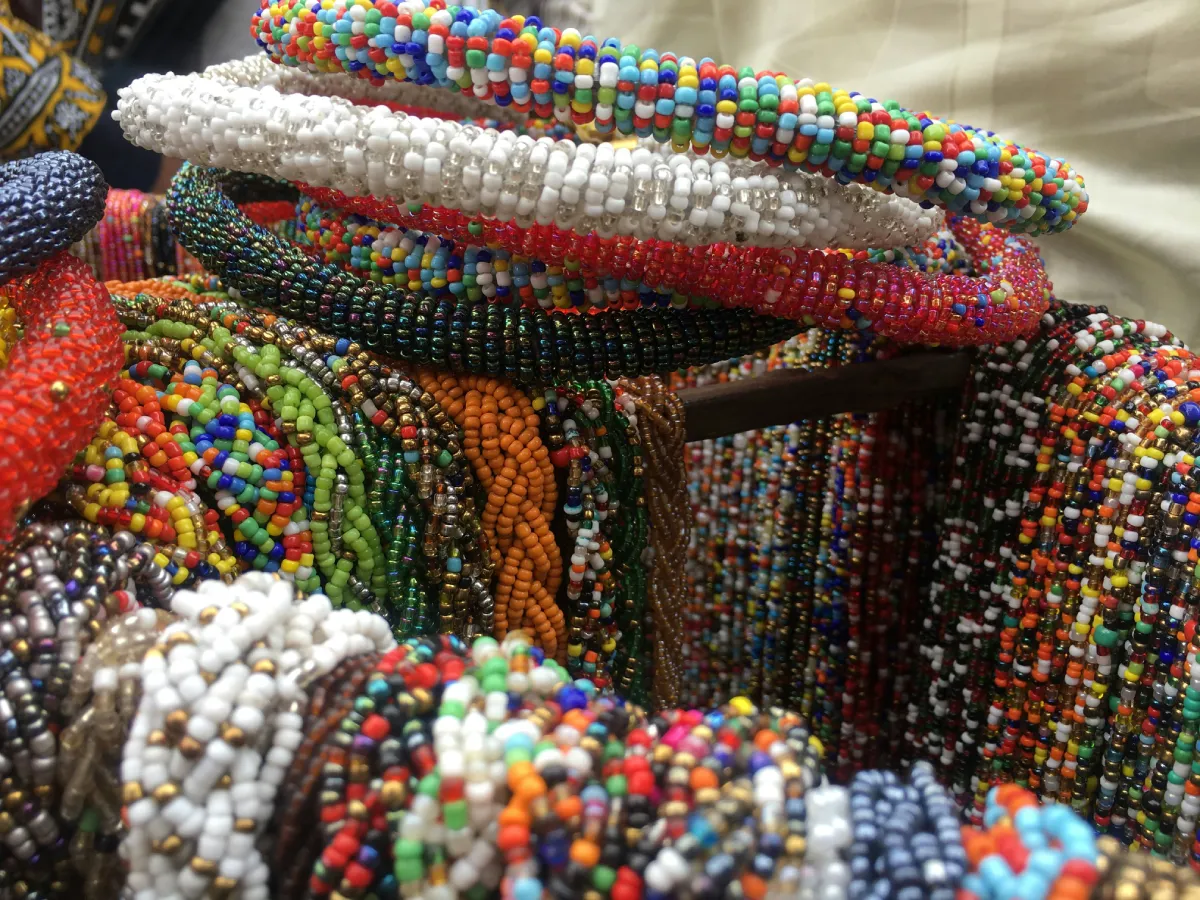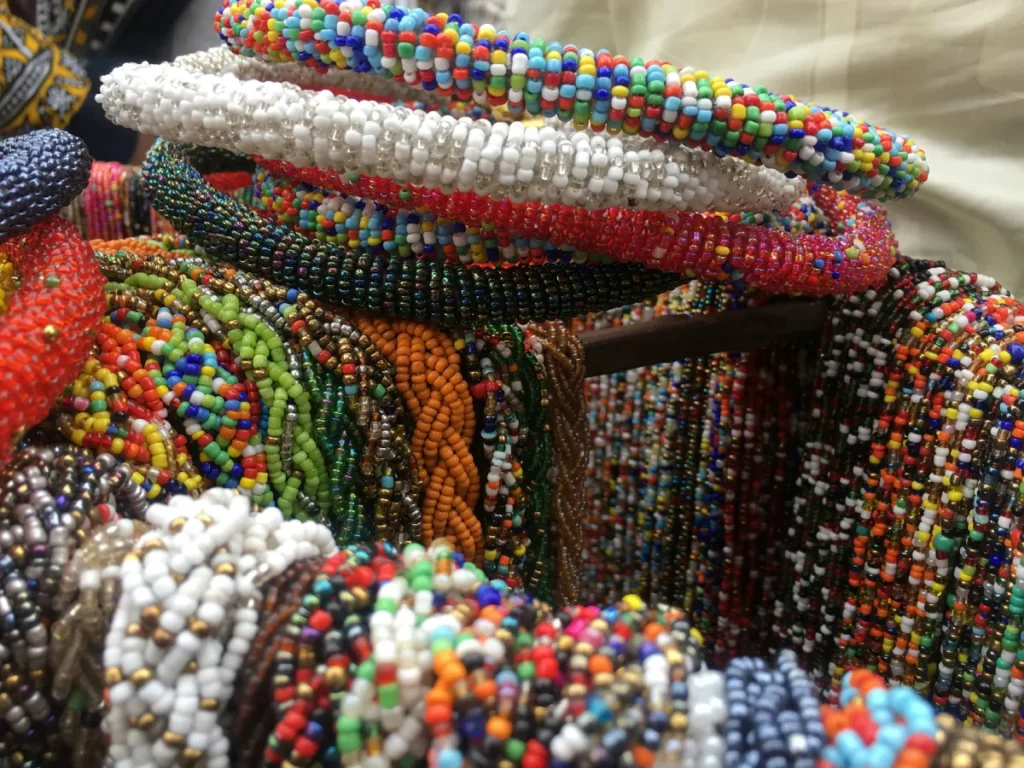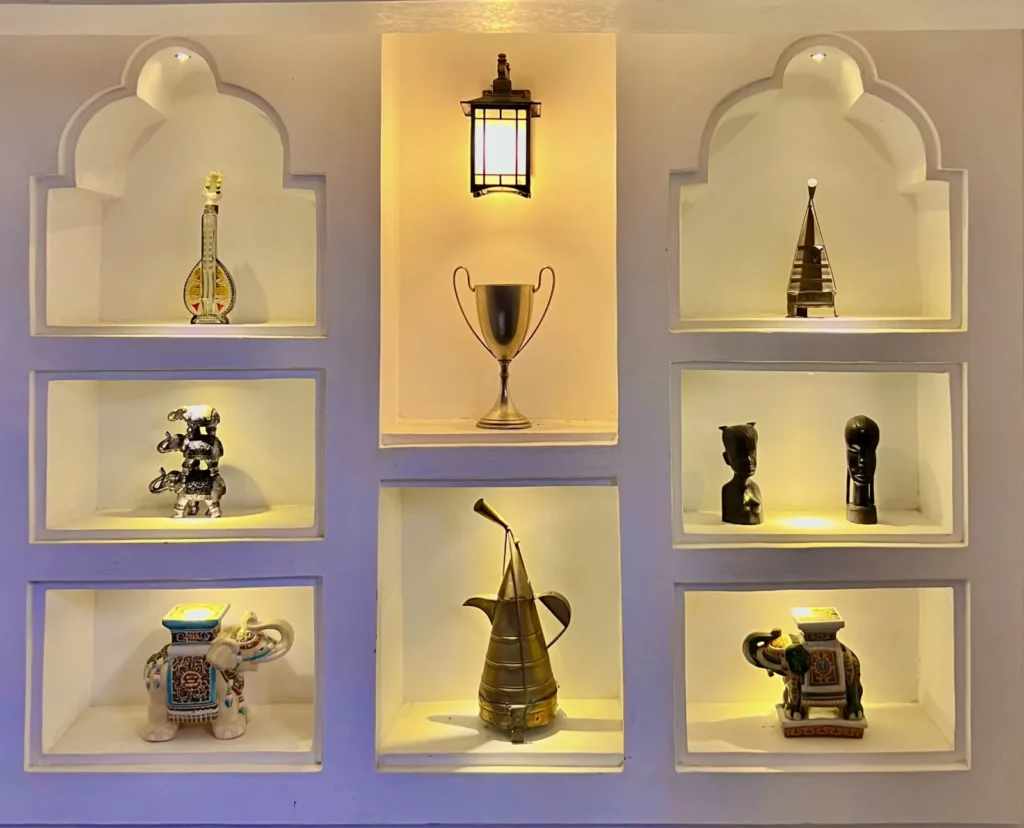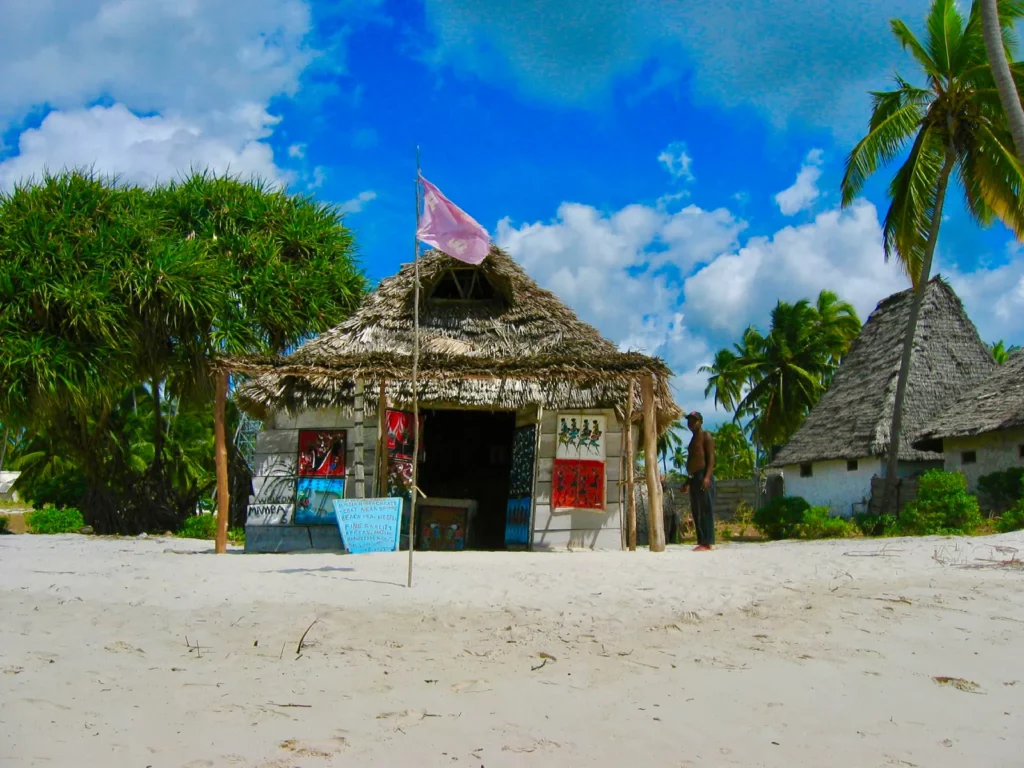The Spirit of Zanzibar—Told Through Its Crafts

Down a sun-bleached alley in Stone Town, a woodcarver leans over a block of mvule, tapping a rhythmic groove into the grain. Not far away, women in colorful kangas sit beneath a baobab tree, weaving raffia strips into tight, symmetrical coils. These aren’t performances—they’re the pulse of daily life. In Zanzibar, handicrafts are everywhere, not as ornament, but as continuity.
Here, artistry is not a luxury. It’s a rhythm passed from hand to hand, mother to daughter, apprentice to elder. The beauty is in the detail, and the detail is lived. From spice boxes to fans, baskets to bangles, these objects are more than decorations—they are expressions of heritage, necessity, and skill.
For travelers, they may become treasured souvenirs. But for those who make them, they are culture made tangible—crafted with purpose, shaped by time, and stitched into everyday identity.
overview
Woven with History: The Roots of Zanzibar’s Handicrafts

Long before brochures spoke of beaches, Zanzibar was a merchant’s dream. Arab dhows, Indian traders, and African caravans converged here, bringing more than goods—they brought knowledge, materials, and motifs. The island absorbed it all and wove it into something uniquely Swahili.
Zanzibar’s handicrafts reflect this deep-rooted hybridity. You’ll find Omani brass patterns carved into local wood, Indian symmetry in block-printed cloth, and East African rhythm in beaded jewelry. The blend isn’t accidental. It’s the DNA of a culture that has always lived in motion.
Natural resources shape the crafts. Neem, mango, and coconut wood are carved. Palm and banana fibers are woven. Sea glass and cowrie shells are transformed into ornaments. Artisans dye fabrics with turmeric, charcoal, or hibiscus, then hang them on lines strung between stone houses.
None of this is outsourced. Everything is locally made, crafted by hand, and rooted in both land and lineage.
The Many Faces of Zanzibar’s Handmade Treasures
Carved Wood: Storytelling in Grain
Zanzibar’s iconic doors are more than entrances—they are stories told in timber. Every swirl, stud, and floral burst is symbolic: wealth, faith, protection, identity. This tradition lives on in smaller forms—spice boxes, trays, wall panels, and stools.
Local artisans shape mvule and teak using simple tools and deep memory. Some sketch patterns first. Others carve from instinct, their fingers guided by years rather than rulers.
Each piece feels grounded. These wooden handicrafts don’t scream for attention. They carry quiet authority, marked by heritage and the strength of touch.
Swahili Textiles: Proverbs You Can Wear
A woman walks through the market, her kanga fluttering behind her, printed with a proverb in Swahili: “Majivuno hayafai” (“Pride is useless”). Her message is visible, elegant, and culturally specific.
The kanga is daily wear and dialogue. Brightly colored, bordered with design, and anchored by a message, it’s more than fashion—it’s commentary.
Beside it, kitenge cloth offers bolder patterns for tailoring, and batik prints dyed with wax echo centuries of craft. These textiles are made in small workshops where hands mix dye, press blocks, and dry fabric in coastal wind.
As souvenirs, they’re unmatched—light to pack, rich in meaning, and wearable as memory.
Jewelry and Beads: The Sea’s Keepsakes

Coconut shell, coral, recycled brass, cowries—Zanzibar’s jewelry is born of sea and soil. A necklace might combine beach glass with hammered metal. A bracelet could carry a Swahili verse etched in silver.
These are not polished showroom pieces. They’re irregular, textured, and unmistakably handmade. Each one carries the imprint of its maker and the essence of place.
You’ll find them in market stalls, small boutiques, and even from the maker herself—beading by lantern light, surrounded by children and conversation.
Among all Zanzibar’s handicrafts, jewelry is the most portable, the most personal—and often, the most quietly powerful.
Raffia and Palm Weaving: Functional Elegance
Across the island, women gather in porches and courtyards, their hands moving steadily over coils of palm fiber and raffia. They weave baskets, fans, mats, and trays—not as art objects, but as tools for life.
These goods support homes, not just functionally, but economically. Cooperative groups in rural villages sell their work to hotels, beach markets, and travelers, turning tradition into income.
Every weave pattern tells of repetition, muscle, and inherited method. The dyes come from the kitchen, the fibers from the garden, and the value from effort.
They are among the most direct expressions of how handicrafts sustain the local economy—beautiful, yes, but purposeful above all.
Spice and Scent: Crafting with the Island’s Soul
Zanzibar’s nickname—The Spice Island—isn’t just a branding flourish. The island’s fertile soil and humid air produce some of the world’s finest cloves, nutmeg, cinnamon, and cardamom. But these aren’t only exported as ingredients—they’re transformed into tangible memories. In Zanzibar, spices are as much a part of its handicrafts as wood or raffia.
You’ll find cloves strung into necklaces, bundled in batik bags, and pressed into carved wooden boxes. Some are arranged in intricate patterns on woven mats or pressed into handmade soaps and incense. In small family-run workshops, spices are blended with coconut oil to create locally scented balms—each one carrying the warmth of the sun and the essence of Swahili gardens.
This fragrant creativity turns ordinary kitchen staples into authentic souvenirs. A clove sachet becomes a drawer keepsake. A cinnamon soap becomes a scent of travel. These spice-based handicrafts are light, portable, and full of sensory narrative.
How Zanzibar’s Handicrafts Compare Across Africa

Africa is a continent of craft. From Ghana’s bold kente cloth to Kenya’s beaded collars, from Morocco’s mosaic tiles to Mali’s mudcloths—each region carries its own visual vocabulary and symbolic weight.
But Zanzibar’s handicrafts speak differently. They don’t aim for grand spectacle. Instead, they hum with subtlety. The patterns are softer, the colors more coastal, the symbolism more whispered than shouted. There’s elegance in the restraint. Where Maasai beadwork demands presence, a kanga suggests. Where West African carvings lean toward the geometric, Zanzibar’s curves inward.
That quiet aesthetic didn’t emerge in isolation. It was shaped in the winding alleys and coral-stone homes of Stone Town, where for centuries, wealth flowed from clove trade, ivory, and gold. Arab merchants, Persian nobles, and Indian financiers established homes and businesses here—not merely as economic outposts, but as cultural centers. They brought with them textiles, metalwork, calligraphy, architecture, and above all, a reverence for fine detail.
This blend of traditions layered itself into the fabric of Swahili culture. Indian block-printing and embroidery influenced local textile design, Persian motifs inspired repeating floral and vegetal forms in woodcarving, and Arab geometry became a foundational language for Swahili ornament. Calligraphic flourishes and the clean balance of Islamic design principles merged with East African rhythm and material sensibility, giving rise to a refined and deeply harmonious visual style.
Stone Town, as the political and cultural capital of the Sultanate, became a canvas for this blended artistry. Wealthy traders commissioned ornate wooden doors with Quranic inscriptions and carved floral patterns; silversmiths embedded coral and lapis into jewelry designs; tailors stitched Indian silks into Swahili silhouettes. Over time, a uniquely Zanzibari culture of fine arts flourished—one that prized subtlety over spectacle, and intricacy over excess.
This legacy still lives on in today’s handicrafts. The same sensibility guides the artisans who carve small boxes, weave palm into complex geometric patterns, or print kangas that speak through proverb. Each item feels deliberate, composed, and at peace with itself.
Much of this has to do with the values embedded in Swahili aesthetics. Rooted in centuries of trade, cross-cultural dialogue, and Islamic influence, it favors repetition, symmetry, and restraint. The island’s palette—saffron, indigo, sand, seafoam—comes not from trends, but from the natural world. It reflects the ocean, the soil, the spices, and the rhythm of monsoon winds.
Unlike factory-made items found in tourist traps, most Zanzibar crafts are still made in small batches, by real people, in homes or shared spaces. Their uniqueness lies not just in their look, but in their tempo. They are slower, more meditative, and deeply grounded in the lived experience of their makers.
It’s this slow-made, detail-rich quality—born of cultural layering and artistic lineage—that makes Zanzibar’s handicrafts so beloved by travelers seeking more than mass-produced décor. They are not simply beautiful. They are historic, personal, and quietly profound.
The Hands Behind the Craft
The Artisans Keeping Culture Alive
Every carved bowl and stitched bag begins with someone—an aunt, a father, a neighbor—passing on knowledge that predates modern schooling. Most artisans learn their craft at home or through informal apprenticeships. It’s less a course than a conversation: “Here’s how we dye raffia with hibiscus,” “This is how your grandmother carved door panels,” “Watch how the wax resists the dye.”
There are no certificates, but plenty of mastery.
In towns like Makunduchi or Matemwe, it’s common to find families producing multiple forms of craft: the father carving, the mother weaving, the children beading or knotting rope into patterns. This is not assembly-line labor. It’s family tradition, sustained and adapted for modern markets.
And while some techniques change—like using synthetic dyes or smartphone flashlights during night work—the root remains deeply Swahili.
Women Weaving the Economy Together
If Zanzibar’s handicrafts have a backbone, it’s women. From basketry to soap-making, weaving to tailoring, women lead much of the production—often while managing households, gardens, and community roles.
In villages across the island, women’s groups and cooperatives have emerged as economic lifelines. Some are informal circles. Others are linked to NGOs or social enterprises focused on empowering rural artisans.
The impact is tangible. A fan sold at the night market might fund school shoes. A beaded anklet might pay for prenatal visits. A batch of woven mats might install a rainwater tank.
Through craft, women aren’t just preserving cultural heritage. They’re shaping the present.
And for travelers buying their work, that connection adds weight. You’re not just taking home a handmade souvenir—you’re participating in someone’s livelihood.
The Invisible Threads of the Industry
The Web of Economic Impact

Beyond the market stalls, Zanzibar’s handicrafts ripple outward through a quiet, interconnected economy. A carver needs wood—cut locally, dried properly. A weaver needs raffia—harvested, cleaned, dyed. A jewelry maker might rely on someone collecting sea glass or trading brass scraps.
There are toolmakers, transporters, vendors, middlewomen. There are hotel managers commissioning local decor. There are small shops specializing in curated crafts, creating predictable outlets for uncertain incomes.
It’s not a centralized industry—but it is an ecosystem. One where every purchase feeds several mouths, and every product tells more than one story.
Unlike imports passed off as “local,” these objects are anchored in place—physically and economically. That matters.
From Zanzibar to the World
Some artisans have begun selling beyond the archipelago. A few have Etsy stores, Instagram pages, or links with diaspora communities abroad. Others partner with Tanzanian boutiques in Arusha or Dar es Salaam. One weaving cooperative recently began shipping baskets to a sustainable design shop in Denmark.
These pathways are still developing—but they show the potential of exporting authenticity without compromising integrity.
Zanzibar’s handicrafts may not flood global markets. But that’s not the point. Their strength lies in being specific, grounded, and human.
They don’t scale. They resonate.
Conscious Collecting: How to Shop with Meaning
Markets in Zanzibar are alive with color, rhythm, and texture. But among the noise of tourist kitsch, the island’s true treasures whisper instead of shout. The best handicrafts aren’t flashy—they’re honest. They carry the weight of time and the touch of a person who made them by hand.
To shop well here is to shop slowly. Look closely. Ask questions. A fan woven from raffia may have paid for a child’s medicine. A carved box might hold a grandfather’s design, passed on in silence. These objects are not souvenirs in the usual sense—they’re quiet extensions of the island’s memory.
If you listen, they’ll speak.
Where to Find the Real Thing
Stone Town’s Artisan Nooks
In the maze of Stone Town, handicrafts line the narrow streets—but not all are created equal. Along Gizenga Street and the alleys behind the market, you’ll find both curated boutiques and small family-run shops. The difference is often in the detail.
Shops like Memories of Zanzibar and Fahari Zanzibar are known for offering ethically sourced, locally made items. They work directly with artisans, especially women’s groups and social enterprises. From fabric accessories to carved utensils, what you buy here is connected to real people—not supply chains.
But don’t stop at the big names. Peer behind the curtain of a modest shop, and you may discover someone carving right there in the back—tools worn, hands callused, and years of heritage flowing quietly through wood.
Village Markets and Coastal Stalls

Beyond Stone Town, the real texture of Zanzibar’s handicrafts is found in its coastal villages. Places like Jambiani, Paje, and Bwejuu host informal markets, often without signs or set hours. But what they offer is rare: direct access to the makers.
You’ll meet women weaving palm baskets under mango trees, children threading beads beside them. You’ll find tie-dyed kangas drying on wooden fences, and carved spoons laid out in the sand. These are not mass-produced—they are humble, slow-made, and full of story.
In some villages, cooperatives host weekly sales events where travelers can browse, bargain, and connect. The atmosphere is warm, the prices fair, and the authentic value of the experience unmatched.
Here, buying handicrafts becomes more than a transaction—it becomes a memory made tangible.
The Impact Behind Every Purchase
More Than a Token: Supporting the Local Economy
Every piece of Zanzibar’s handicrafts tells a story—but it also pays a bill. A hand-carved bowl might cover a week of school transport. A basket sold at the beach could buy maize for the family. A kitenge purse stitched by a grandmother helps her avoid dependence.
This isn’t sentimentalism. It’s the real function of the handicrafts industry: sustaining lives, especially in rural areas where few other economic options exist.
Through cooperatives, women’s circles, and informal networks, craft-making has become one of the most reliable sources of income for hundreds of households across the island. It may not make headlines—but it makes dinner.
And for travelers who value cultural engagement, there’s no better way to contribute directly to the local economy.
Preserving Culture Through Craft
Tourism has its risks—commodification, exploitation, erosion. But when it intersects with traditional craft, it can also be a force for preservation.
Every kanga with a proverb, every Swahili-style carving, every raffia tray made the old way reinforces the value of that knowledge. It tells young makers that what their elders know still matters.
By choosing to buy true Zanzibar crafts, travelers cast a quiet vote for the continued survival of Swahili design, rhythm, and meaning. These objects are not just physical—they’re pedagogical. They teach continuity. They validate roots.
And in doing so, they help keep cultural heritage alive.
What You’re Really Taking Home
Souvenirs That Last Longer Than a Trip
A factory-made fridge magnet fades. A mass-produced beach wrap frays. But real handicrafts endure—because they’re made with intention, and they’re chosen with care.
That carved spoon you pack might live in your kitchen for years. The basket might carry fruit, stories, and reminders. The cloth might be draped, worn, gifted, or kept close.
These items don’t end when your trip does. They continue. They accumulate meaning, long after the salt has washed from your sandals.
A Quiet Conversation with Place
Every traveler wants to take something home. But not every object speaks. Zanzibar’s handicrafts do.
They whisper of time. Of slowness. Of hands that move with practiced rhythm and a kind of creative patience lost in most of the modern world.
This isn’t unique to Zanzibar. Along the Swahili coast, in places like Lamu and Mombasa, you’ll find similar traditions—carved wooden doors, handwoven mats, calligraphy, beadwork, silver bangles, even the same love for proverbs printed on kangas. These towns, too, were built by traders, shaped by monsoon winds and cultural exchange.
But while the spirit is shared, the details diverge.
Lamu’s crafts are often more rustic, reflecting the town’s laid-back pace and insular charm. Carvings lean simpler, more raw. Fabrics often bear subtler motifs. Mombasa, being more urban and commercially connected, offers a greater variety but sometimes loses the artisan’s fingerprint in favor of volume.
Zanzibar, in contrast, straddles that line between elegance and earthiness. Its handicrafts carry the refinement of Stone Town’s merchant history and the coastal soul of the villages. The result is a collection of crafts that feel at once sophisticated and deeply local.
So as you wander the markets, hold an item a little longer. Ask who made it. Learn what it’s for. Feel its weight.
Then, when you’re home and you reach for it—whether it’s a fan, a carving, a cloth—you’ll remember more than the beach. You’ll remember that conversation. That connection. That place.
And that’s what makes it worth carrying.


